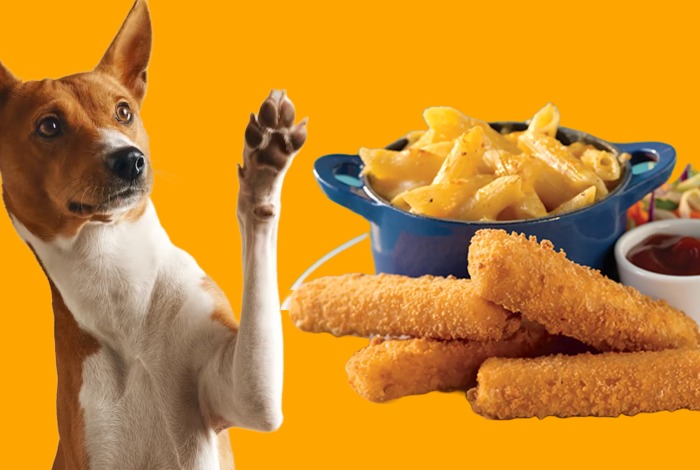The answer to the question: Can dogs eat fish sticks is… Yes.
Let me clarify my response, though.
Actually, this isn’t a yes-or-no question. To find out why fish sticks are bad, you have to do a thorough investigation.
In general, your dog shouldn’t eat processed food. If you truly want to feed them fish, either grill or cook the fish or get dog kibble on Amazon that contains fish.
A pescatarian diet is fantastic and has a ton of incredible advantages that you probably aren’t aware of.
More About Fish Sticks?
A variety of fish types are combined and breaded to form fish sticks or fish fingers. Food brands typically use white fish, such as cod, hake, haddock, and pollock, to make them. Fish sticks are produced by simply chopping and grinding various fish parts.
Indeed, bones also get ground!
After that, fish fingers are beaten and frozen. Usually at a low cost, you can find them in food aisles with frozen goods. Their cost certainly speaks volumes about their caliber.
Without first thawing, fish sticks are prepared for oven baking, deep- or shallow-frying, or grilling. In case you were unaware, abruptly thawing frozen food can exacerbate existing issues and introduce bacteria that grows quickly.
This isn’t a nutritious dinner for anyone, much less canines!
Can Dogs Eat Fish Sticks?
Dogs are technically allowed to eat fish sticks. However, that does not imply that they ought to.
Unlike some foods, fish fingers don’t poison dogs, but if they are overindulged in some of their ingredients, they may be harmful.
Of course, you could offer a fish stick as a treat once in a while, but let’s not make that a routine. If your dog snatches a fish finger off your plate, nothing will happen to him.
You see, the recipe for the fish sticks contains a lot of seasonings, which are actually unhealthy for your dog. Food brands usually add onion powder and garlic powder to enhance the flavor.
Dogs shouldn’t consume fresh or powdered onions or garlic. These seasonings may not poison your dog, but they can induce nausea, diarrhoea, and other digestive issues.
Additionally, fish sticks are overly salted for both humans and dogs. Salt can lead to severe dehydration and salt poisoning in dogs, so it’s best not to feed them salt.
The breading or coating of fish fingers should be your last concern. Dogs should not be exposed to excessive amounts of oil when breading.
Are There Any Healthy Substitutions To Fish Sticks?
The only nutritious substitute for fish sticks is real fish that has been cooked to eradicate bacteria and parasites without the use of pesticides.
It is advised by veterinarians that you select fish that is high in omega-3 fatty acids. Fish is always my first choice. It’s true that this fish is among the best tasting in the world.
When baking salmon, it’s best to leave out any seasonings like salt. To ensure your dog can eat it without any trouble, simply bake it for 10 to 15 minutes, then chop it into small pieces.
Salmon is a great source of healthy fats that help dogs’ bones, brains, and inflammations.
In addition to salmon, cod and sardines make excellent choices. Just be sure to purchase those that are canned in water and natural juices rather than oil.
Types of Fish Dogs Cannot Eat
It is not safe for your dog to consume any large fish that has a long lifespan. Large fish that accumulate heavy metals, like albacore tuna, king mackerel, swordfish, and tilefish, pose a hazard to dogs due to the high levels of mercury in their systems.
6 Types of Fish Dogs Can Eat
If you cook it and take out the bones, your dog can eat a variety of fish in tiny portions. Dogs have access to food:
- Cod: Often found in commercial dog food, cod can provide your dog with a healthy amount of protein.
- Haddock: As a source of protein, you can include cooked haddock in your dog’s diet. Haddock is a great source of healthful omega-3 fatty acids.
- Flounder: Your dog can benefit greatly from this mild whitefish as a source of protein.
- Salmon: As a source of omega-3 fatty acids and selenium, cooked salmon is healthy for your dog. However, dogs should not eat smoked salmon due to its high salt content and potential for harmful bacteria that can cause salmon poisoning.
- Sardines: Your pet may benefit from this oily fish as a source of protein and important fatty acids. Never fry fresh sardines; if you must use canned sardines, make sure the fish is packed in water rather than oil.
- Tilapia: Although mild, don’t season this fish when cooking it for your pet.
Frequently Asked Questions
Q: Are fish sticks safe for dogs to eat?
A: While fish is generally safe for dogs and can be a healthy addition to their diet, fish sticks might not be the best choice due to added ingredients and potential hazards.
Q: What are the concerns with feeding fish sticks to dogs?
A: Fish sticks often contain additives like breading, seasonings, and preservatives, which may not agree with a dog’s digestive system. Additionally, some fish sticks may contain high levels of sodium, which can be harmful to dogs in large amounts.
Q: Can dogs have fish sticks occasionally?
A: It’s not recommended to make fish sticks a regular part of a dog’s diet. If you want to give your dog fish, it’s safer to offer them plain, cooked fish without any added ingredients.
Q: What should I do if my dog eats fish sticks accidentally?
A: If your dog consumes a small amount of fish sticks, they may be fine, but keep an eye out for any signs of digestive upset such as vomiting, diarrhea, or lethargy. If your dog shows any concerning symptoms, contact your veterinarian for advice.
Q: What are some healthier alternatives to fish sticks for dogs?
A: Instead of fish sticks, you can offer your dog plain, cooked fish like salmon, tuna, or cod. Just make sure it’s thoroughly cooked and free from any bones or seasoning. You can also consider fish-based dog treats made specifically for canine consumption.
Q: Are there any benefits to feeding fish to dogs?
A: Fish can be a good source of protein and omega-3 fatty acids, which can promote a healthy coat, skin, and immune system in dogs. However, it’s essential to ensure that the fish is prepared in a way that’s safe and suitable for canine consumption.
Always consult with your veterinarian before making any significant changes to your dog’s diet to ensure it meets their nutritional needs and dietary requirements.

